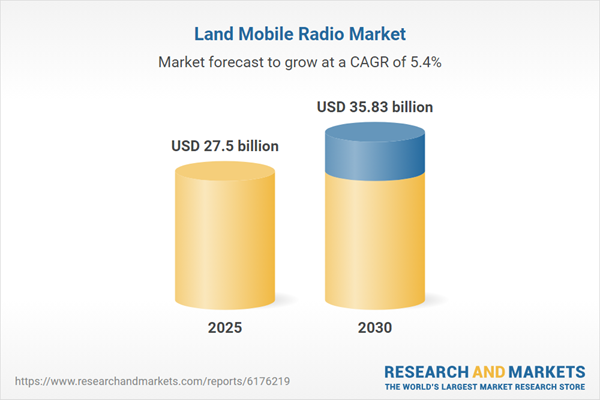Land Mobile Radio Market Size:
The Land Mobile Radio Market is expected to grow from USD 27.495 billion in 2025 to USD 35.833 billion in 2030, at a CAGR of 5.44%.Land Mobile Radio (LMR) systems, utilizing push-to-talk technology across portable, vehicle-mounted, and fixed-base platforms, provide secure and instant communication for various industries. The market is driven by growing demand for reliable, cost-effective LMR systems, particularly in transportation and military & defense sectors. The transition from analog to digital LMR systems enhances performance, supporting advanced features like data integration and real-time collaboration. Increased research and development, alongside technological advancements and modernization of manufacturing processes, are key growth catalysts. Emerging economies present new opportunities as demand for robust communication solutions rises. However, challenges such as limited channel capacity, deployment complexity, frequency spectrum scarcity, and high manufacturing and setup costs hinder market expansion.
Market Growth Drivers
Growing Application in the Military and Defense Sector
The military and defense sector significantly drives the LMR market, as law enforcement and emergency responders increasingly rely on these systems for mission-critical communication during crises like natural disasters and terrorist attacks. LMR systems enable real-time decision-making by integrating voice communications, data applications, and command center functionalities. This allows responders to access video, data, and collaborative tools, enhancing operational efficiency. The demand for specialized LMR equipment, such as intrinsically safe radios for hazardous environments, underscores the sector’s reliance on secure, reliable communication systems. Ongoing investments in defense communication infrastructure further propel market growth, as agencies prioritize advanced LMR solutions to support public safety and emergency response.Transition to Digital LMR Systems
The shift from analog to digital LMR systems is a major growth driver, offering improved clarity, security, and functionality. Digital systems support advanced features like data transmission, encryption, and integration with modern communication platforms, making them ideal for industries requiring robust, real-time communication. This transition enhances system interoperability and scalability, meeting the evolving needs of sectors like transportation and defense. The adoption of digital LMR systems is further supported by R&D efforts focused on improving system performance and reducing latency, driving market expansion as organizations upgrade legacy systems.Market Restraints
High Initial Cost and Power Consumption
High initial costs pose a significant barrier to LMR market growth. While LMR systems offer superior coverage compared to other wireless technologies, the expenses associated with equipment, installation, and service can be substantial. In some cases, initial costs exclude equipment, covering only service fees, which can escalate when hardware is included. Additionally, high-power mobile radios require significant energy, necessitating large batteries to support extended transmission over long distances. This high power consumption increases operational costs and complicates deployment in resource-constrained environments, limiting market adoption, particularly for smaller organizations or budget-sensitive sectors.Market Outlook
The LMR market is poised for growth, driven by its critical role in military, defense, and transportation sectors, where reliable communication is paramount. The shift to digital systems and advancements in manufacturing processes enhance system capabilities, supporting broader adoption. Emerging economies offer growth opportunities as they invest in modern communication infrastructure. However, addressing constraints like channel capacity, spectrum scarcity, and high costs will be essential to unlocking the market’s full potential. Continued innovation in cost-effective, energy-efficient solutions will drive long-term expansion.Key Benefits of this Report:
- Insightful Analysis: Gain detailed market insights covering major as well as emerging geographical regions, focusing on customer segments, government policies and socio-economic factors, consumer preferences, industry verticals, and other sub-segments.
- Competitive Landscape: Understand the strategic maneuvers employed by key players globally to understand possible market penetration with the correct strategy.
- Market Drivers & Future Trends: Explore the dynamic factors and pivotal market trends and how they will shape future market developments.
- Actionable Recommendations: Utilize the insights to exercise strategic decisions to uncover new business streams and revenues in a dynamic environment.
- Caters to a Wide Audience: Beneficial and cost-effective for startups, research institutions, consultants, SMEs, and large enterprises.
What do businesses use these reports for?
Industry and Market Insights, Opportunity Assessment, Product Demand Forecasting, Market Entry Strategy, Geographical Expansion, Capital Investment Decisions, Regulatory Framework & Implications, New Product Development, Competitive IntelligenceReport Coverage:
- Historical data from 2022 to 2024 & forecast data from 2025 to 2030
- Growth Opportunities, Challenges, Supply Chain Outlook, Regulatory Framework, and Trend Analysis
- Competitive Positioning, Strategies, and Market Share Analysis
- Revenue Growth and Forecast Assessment of segments and regions including countries
- Company Profiling (Strategies, Products, Financial Information, and Key Developments among others.
Land Mobile Radio Market Segments:
By Type
- Digital
- Analog
By Industry
- Military and Defense
- Aviation
- Mining
- Marine
- Others
By Geography
- North America
- USA
- Canada
- Mexico
- South America
- Brazil
- Argentina
- Others
- Europe
- Germany
- France
- United Kingdom
- Spain
- Others
- Middle East and Africa
- Saudi Arabia
- UAE
- Others
- Asia Pacific
- China
- India
- Japan
- South Korea
- Indonesia
- Thailand
- Others
Table of Contents
Companies Mentioned
- Harris Corporation
- Sepura
- Thales Defense & Security, Inc.
- BK Technologies
- Tait Radio Communications
- Hytera Communications
- Simoco
- JVC Kenwood Corporation
- Motorola
- Anritsu
Table Information
| Report Attribute | Details |
|---|---|
| No. of Pages | 146 |
| Published | August 2025 |
| Forecast Period | 2025 - 2030 |
| Estimated Market Value ( USD | $ 27.5 billion |
| Forecasted Market Value ( USD | $ 35.83 billion |
| Compound Annual Growth Rate | 5.4% |
| Regions Covered | Global |
| No. of Companies Mentioned | 10 |









